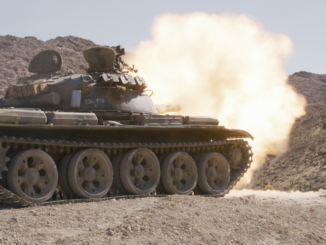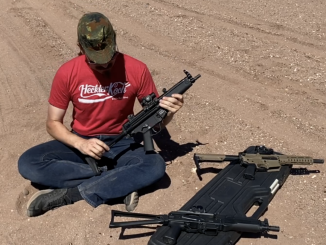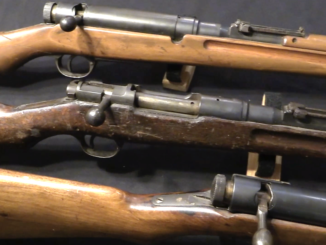The Soviet Union adopted its first submachine gun in 1935 after trials of some 14 different design in 1932/33. The winner of the trials was Vasily Degtyarev, once of the Soviet Union’s most prolific firearms designers. His model 1934 was a simple blowback gun reminiscent of the MP-28,II albeit with different trigger and magazine systems. The PPD34 und a 25-round box magazine, chambered for 7.62x25mm Tokarev. It was put into slow production, with just 3,300 or so produced by the end of 1938. During that time, Degtyarev made a number of small improvements to the gun, smoothing out the teething problems that are always found in new production systems. This improved version was designated the PPD34-38.
During the time, the submachine gun was not considered a priority by the Red Army. The leading generals did not see the value in the class of arms, and actually pulled all the PPDs from service in 1939 and had them put into storage. Only a few months later, the Red Army would be given a grim demonstration of SMG effectiveness when they closed the border into Finland and encountered determined Finnish resistance with kp/31 Suomi SMGs.
Some Suomis were captured by Soviet troops, and were very well liked – for obvious reasons. The inevitable inquiry into why the Red Army did not have such a weapon led to a frantic re-issuing of PPDs and production of as many as possible. At Stalin’s direction, the Suomi drum magazine was copied and adapted to the PPD34-38 as well. This required the addition of a short feed tower to fit the magazine well initially deigned for a standard box magazine. While PPD34-38 production continued, the PPD40 was quickly designed and put into production alongside the older model. Eventually, both were replaced in service by the PPSh-41, which was truly deigned for mass industrial production.




“Pistolyet Pulyemyot Degtyaryova.”
now that its been finally proven that the Russians DID get a stg44 and cheap it out to make the AK, i really don’t think Kalashnikov should get the recognition and credit he does.
About all the Russians took from the Haenel design was the layout. As far as the action goes, the AK system is basically that of the Garand M1 with the gas piston above the barrel instead of under it.
The receiver design, including the safety/selector gadget, was copied directly from the Remington Model 8/81, which was designed by John Moses Browning.
It may have been made in Russia, but the Avtomat Kalashnikov Obr 1947 was a very “all-American” design.
cheers
eon
“(…)was a very “all-American” design.(…)”
Not exactly, whilst selector is akin to Remington Model 8 safety, hammer-trigger mechanism was most probably borrowed from ZH-29.
People are too eager to accuse other countries of stealing from the Germans without acknowledging that the Germans pinched a lot of ideas from other countries themselves.
At this point in the development of small arms, there’s really not a hell of a lot of “new and innovative” stuff to be done; you are, I’m afraid, re-inventing the wheel.
About all that’s left is examining the entrails for what has worked, and then taking that to integrate into a “new” mechanism. If you were to draw out the “genetic lines” of things going into these designs, you’d rapidly find that there’s damn little actual “inspiration and innovation” going on. Mostly, it’s rehash and reinterpretation, all the way down.
Hell, go watch Othais over on C&Rsenal. He’s actually gone back to look at all the designs and patents for European revolvers, and what he’s found is that there’s really an awful lot missing from the conventional histories.
I have to give Kalashnikov credit; he managed to parlay his work into one hell of a career, and while I suspect that there was a lot of copying and politics behind it, the man did manage to produce what I have to regard as one of the best machine guns of the 20th Century, the PK. And, it’s basically an upside-down rehash of his AK, soooo… Can you commit plagiarism against yourself?
Long story short, it’s all copying, all the way down. The trick is, how well did you do it, and does it work? Kalashnikov very obviously got it right; compared to the idiots who created the M60 from the bones of the FG42, Lewis Gun, and the MG42? Yeah; those fools couldn’t even copy things correctly, and clearly did not understand what they were looking at when they did it. The vestigial remnant of the firing pin booster spring from the FG42 in the M60 proves that conclusively, along with their failure to include the relief cuts for the operating rod tower in the bolt.
I’d lay you long odds that if Kalashnikov had been handed that particular dog’s breakfast, he’d have done the copying right, and either included those features or figured out a way to make them unnecessary in the first damn place. In that alone, the man deserves his reputation…
“(…)Can you commit plagiarism against yourself?(…)”
Apparently someone working as scholar could do so https://ori.hhs.gov/self-plagiarism
…when applied to research and scholarship, self-plagiarism refers to authors who reuse their own previously disseminated content and pass it off as a ”new” product without letting the reader know that this material has appeared previously.
“(…)stg44(…)AK(…)”
So which one features exactly were copied on behalf of M.T.Kalashnikov?
“(…)really don’t think Kalashnikov should get the recognition and credit he does.(…)”
So it looks now you have mission: educate others on effort made by A.A.Bulkin regarding development of said weapon.
That guy is a troll and his comments always seem to be worded in a way to start arguments not discussions. Ignore him.
There are quite a few of those around “gun pages”
Proven where?
You want to hear a funniest thing ever?
If you tasked russians/soviets in 1945. or later, to actually copy/clone and make from ground up Stg44 down to the last pin and screw, not using any of existing captured german parts, they would not be able to do it !
Their stamping technology was way behind.
No one likes to recognise that until there’s a war, gangsters do a lot more gun using than soldiers.
I would not take the various gang-bangers of the world as objects of emulation, with regards to small arms design or usage. Very few criminals are the sort of people that actually think about what they’re doing, or how to do it better.
I would propose an alternate construct: Nobody thinks shooting is important until the shooting starts, and then they tend to pick the wrong things to focus on. It’s endemic to any sort of low-frequency human activity; if you don’t deal with brush fires every single year of your life, you forget how to fight them. Meaning that when you do have to fight one, your tools are in the wrong place, you’ve left fuels all over the property, and there’s a lot of stuff you realize you should or shouldn’t have done along the way…
The gangsters of Chicago wouldn’t have had the Thompson to play with, had Thompson not developed it for WWI, is all I’m saying. The fact that the military mostly ignored the potential of it and the Bergmann? Kinda more indicative of problems with reality-processing within the military, more than “gangster wisdom”.
Actually there was objective reason for abandoning PPD and it was simple price
https://en.topwar.ru/3384-polozhenie-s-avtomaticheskim-oruzhiem-v-predvoennom-sssr.html
PPD-34 cost was 1350
Nagant revolver was 50
Mosin was 90
DP machine gun was 787
SVT-38 was 880
One might question notion of price in centrally-controlled economy, but that does apply to all items listed above, so proportions should hold.
Observe that phasing out PPD and introduction of SVT-38 was close in time.
Then, there’s always the question of who was doing the accounting. If your weapon/product had political backing, then they’d count the beans one way. If it didn’t, they’d count them another, and you’d lose ‘cos they done charged everything from transport costs for the employees down to how much wear went on the brooms from sweeping up after work.
I’ve got an acquaintance of mine who used to be an “accountant” in a Czech manufacturing firm, under the Communists. You get them started on the shenanigans that went on with that, and you’d rapidly lose all faith in anything even vaguely state-run. Under a traditional economy, if you’re lying to yourself about what it costs to build something, you eventually run out of investors who’re willing to front you the cash. In a state-run economy? LOL… So long as you can manage to please the political types, you’re golden.
So, yeah… Maybe the PPD did cost 1350 rubles. Then again, maybe the guys working the numbers had it in for the weapon, and wanted to show how cost-ineffective it was.
This is where it really gets hard to determine what goes into producing anything under a state-run situation. It’s like the accountant says: What do you want it to cost?
The gangster use of SMGS before WW2 was mostly a Hollywood myth. Auto-Ordnance had Colt build about 22,000 component sets for M1921 and M1928 Thompsons in 1922-29. When the British Purchasing Commission showed up in 1940 begging for SMGs, they still had about 21,000 unassembled and unsold.
The USMC had bought about 400 in 1929-32 for the Nicaraguan expedition (the revolution there threatened the Panama Canal Zone). USCG bought 50 in 1925 for boarding rum runners with. The FBI bought 100 in 1934- after Congress authorized them to finally arm their agents that year.
Small numbers were bought by local PDs and state police, mostly for “show”. The biggest buyer outside of government? Warner Brothers Studios. They started using TSMGs in their “gangster” epics in 1930, and by 1940 they owned about 40 TSMGs. You can still finds “Tommies” on the collector market marked “Property of Warner Bros. Prop Dept.”.
Al Capone’s boys used two TSMGs in the “St. Valentine’s Day Massacre”. They were the only two the gang had; Capone bought them from the Cook Co. Sheriff’s Dept., and kept them in a closet in his mom’s house in Cicero.
Dillinger had two TSMGs- that he stole during his famous “carved from soap gun” jailbreak.
The “Gun That Made The Twenties Roar’ did most of its “roaring” shooting blanks on Hollywood backlots.
cheers
eon
Movies certainly make glorious myths and legends, one of more (if not the most ever) annoying, imo, is “1 rifle per 2 soldiers”, from Enemy At The Gates.
It became a staple of ww2 discussions where not too intelligent participants brought it up often as prime “evidence” of how it was with soviets.
“(…)Soviet Union adopted its first submachine gun in 1935 after trials of some 14 different design in 1932/33(…)”
However it was not first sub-machine gun produced in USSR, as this title goes to Tokarev 1927 https://modernfirearms.net/en/submachine-guns/russia-submachine-guns/ppt-27-2/
at least few hundreds were made, they provide very low reliability (it did consumed altered Nagant revolver cartridge)
Two weapons that could generously be described as “submachine guns” predated even the Tokarev gun.
The Frolov self-loading carbine, chambered for the Nagant cartridge, was tested by the Russian Army in 1912. It operated on a delayed-blowback action, but fired in semi-automatic only. Wouldn’t have taken much to modify it into an SMG but of course the potential was never realized at that time.
During WW1 itself, Vladimir Karlovich From developed a triple-barreled, crank-action machine gun chambered for 7.62mm Nagant. It was fired from a wheeled carriage and was also proposed for aerial use. This too was not adopted, for reasons that should be somewhat obvious.
Beyond these two experiments, I am not aware that the Russians ever developed an SMG prior to the late 1920s. They were, however, aware of Italian SMG concepts like the Villar Perosa and Revelli-Beretta (which wasn’t an SMG itself but inspired Degtyarev’s 1931 submachine gun, which is a Revelli-Beretta copy).
“(…)His model 1934 was a simple blowback gun reminiscent of the MP-28,II albeit with different trigger and magazine systems.(…)”
Not sure if that was inspiration, however as control sample Rheinmetall was used see 2nd photo from bottom
https://www.kalashnikov.ru/itogi-ispytanij-otechestvennye-pistolety-pulemyoty-chast-5/
which author reveal to be MP.19 which mean it is early form of Steyr-Solothurn MP.34 https://modernfirearms.net/en/submachine-guns/austria-submachine-guns/steyr-solothurn-mp-34-eng/ and that itself is arch-enemy of MP.18/I
Earlier Degtyaryov designs does look as dwarf DP, see drawing 86-2
https://www.earmi.it/armi/atlas2/659.htm
however it is NOT flapper-locked, it is actually flapped-delayed (i.e. it does belong to delayed blow-back category)
15:40 into the movie: Actually the PPSh-41 wasn’t REPLACED by PPS-43, but merely SUPPLEMENTED by it. The Sudayev was designed as a specialist weapon, offering features that frontline PPSh did not offer, being a kind of PDW weapon for NCOs, junior officers, radiomen, tankmen, recce personnel etc. Only 2 millions PPS were made (in Soviet scale it was “only”) against 5+ million of the PPSh – and both the PPSh and PPS were manufactured alongside all the time until 1945, when both were discontinued – soon to be replaced by the AK
This has been my understanding for a long time – PPS did not replace PPSh to full extent. Btw as I recall I saw PPS (Sudayev) in hands of Polish border guard in 1961; it took me a bit by surprise; I’d expect them to carry at least SKS if not AKM.
Another excellent presentation by Ian of this classical Soviet early SMG. Thank you.
It would be interesting to see actual back to back firing comparison between PPD and PPSh.
Speaking of “SMGs were considered a police weapon,” I recently came across an on-line article that stated the NKVD bought some Thompson guns (part of that run of 22,000?) in the late 1920s – early 1930s.
Speaking as a Chicagoan, Eon2 above is dead wrong about the source of the Capone Tommyguns. One of them started its career as a private purchase by a gang-connected downstate Illinois deputy sheriff in 1924 (not determined if this was a straw-man buy), the other was sold via a sporting goods store in Chicago run by one Peter von Frantzius, “the Armorer of Gangland,” vendor of at least six other Thompson guns to questionable characters. Both guns were later recovered by Michigan police from the home of gangster Fred Burke, and one of those two was determined to have been the murder weapon in the killing of New York mobster Frankie Yale. The Cook County Sheriff’s Department has had its embarrassments over the years, but providing the St. Valentine’s Day Massacre SMGs is not among them.
Who is this Eon2, amd where and why Eon disappeared ? Is it the same person?
I wonder if there’s a difference between the 34 and 34/38 models. I’d assume the two could use most/all of the same parts and magazines.